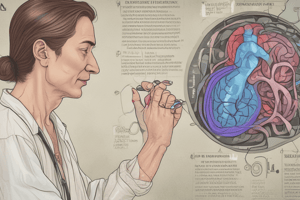Podcast
Questions and Answers
What distinguishes articular joint pain from extraarticular joint pain?
What distinguishes articular joint pain from extraarticular joint pain?
- Articular pain is associated with morning stiffness that improves with activity, while extraarticular pain is associated with intermittent stiffness following inactivity.
- Articular pain limits both passive and active range of motion, while extraarticular pain only limits active range of motion.
- Articular pain is accompanied by swelling and joint instability, while extraarticular pain is characterized by focal tenderness adjacent to the joint. (correct)
- Articular pain worsens with rest and improves with activity, while extraarticular pain shows the opposite pattern.
- Articular pain is characterized by crepitus and deformity, while extraarticular pain is accompanied by fever and inflammation.
How does morning stiffness differ in rheumatoid arthritis (RA) and osteoarthritis (OA)?
How does morning stiffness differ in rheumatoid arthritis (RA) and osteoarthritis (OA)?
- Morning stiffness in RA improves with activity over the day, while in OA, intermittent stiffness follows inactivity and worsens. (correct)
- Morning stiffness in RA is associated with swelling and tenderness, while in OA, intermittent stiffness is accompanied by point of focal tenderness adjacent to the joint.
- Morning stiffness in RA is characterized by crepitus and joint instability, while in OA, intermittent stiffness is accompanied by joint locking.
- Morning stiffness in RA limits active range of motion, while in OA, it only limits passive range of motion.
- Morning stiffness in RA is accompanied by fever, while in OA, intermittent stiffness is not associated with any other symptoms.
How can inflammation be differentiated in joint pain assessment?
How can inflammation be differentiated in joint pain assessment?
- Inflammation is indicated by point of focal tenderness adjacent to the joint.
- Inflammation is assessed by asking about the 4 cardinal signs and any fever. (correct)
- Inflammation is associated with passive range of motion limitation.
- Inflammation is characterized by joint locking and instability.
- Inflammation is accompanied by crepitus and deformity.
Which symptom is indicative of Cauda Equina Syndrome?
Which symptom is indicative of Cauda Equina Syndrome?
What is a common cause of leg pain radiation into the leg and buttocks?
What is a common cause of leg pain radiation into the leg and buttocks?
What type of pain relief indicates spinal stenosis?
What type of pain relief indicates spinal stenosis?
Which symptom is indicative of Cauda Equina Syndrome?
Which symptom is indicative of Cauda Equina Syndrome?
What is a common cause of leg pain radiation into the leg and buttocks?
What is a common cause of leg pain radiation into the leg and buttocks?
How can spinal stenosis be indicated through a specific movement?
How can spinal stenosis be indicated through a specific movement?
Flashcards are hidden until you start studying




